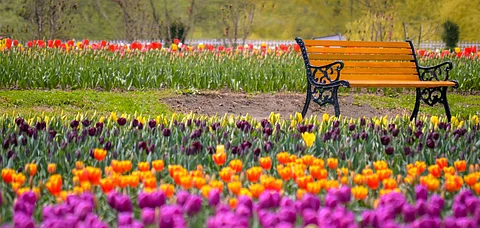
- Destinations
- Experiences
- Stay
- What's new
- Editor’s Picks
- Responsible Tourism
- CampaignsCampaigns
- Subscribe

Kashmir&rsquos natural bounty extends to more than just its picturesque mountainscapes. As one of the most sought after destination for the horticulture enthusiast, Kashmir&rsquos gardens are like a canvas to the state. As the country unlocks in phases, one of the recent developments has been the reopening of parks and gardens in Kashmir after about 100 days. Even though we might not be able to physically visit them yet, here are some glimpses that will show you why they are special.
The history of gardens in Kashmir dates back many centuries, when they resembled orchards lined with not just a variety of flowers but also herbs and aromatic plants. Over the years, they were modified, a major change occurring when influences were drawn from the art of Persian gardening. The concept of paradise in Islam has always been significant. The gardens are like paradise a place where spring is in full bloom, with lush groves and bushes, trees are well endowed with fruits, and the scent of the flowers engulfs the air.
Mughal ruler Babur&rsquos well documented love of gardens can be seen in Kashmir. Both aesthetically and practically fulfilling, the gardens continued to flourish over the years and make for a spectacular sight even today.
Generally characterised by regular arrangement of squares, these gardens were further divided into smaller parterres to form the figure of the char bagh. They are dotted with terraces arranged in descending levels to ensure a continuous flow of water throughout the entire system. In Persia, gardens were meant to be a &lsquorespite from the desert&rsquo, hence irrigation and ensuring continuous flow of water was an important aspect.
Comfortably residing at the foot of the mountains, the gardens in Kashmir are placed near a central water channel, which is sourced by natural springs. Another design aspect that can be spotted are pavilions, which presumably facilitated space for public gatherings.
Many of the elements, of both ideation and design, were brought from Persia with a similarity to the Indo-Islamic architecture. Each element of the landscape can be seen arranged in a geometrical pattern.
Apart from the spectacular Mughal gardens, Kashmir also has some newer additions, including Asia's largest tulip garden and the famous Badamwari Garden.
Badamwari Garden
Although there is no record of who laid the garden, it is speculated that it existed before the 14th century. Situated on the foothills of Koh-e-Maran, the bloom on the almond trees in spring marked the new year for Kashmiris. But over the years, the garden lost its glory. It was only in 2008 that it was restored and formally opened its doors again.
Indira Gandhi Memorial Tulip Garden
Previously known as Siraj Bagh, this one is located on the foothills of Zabarwan mountains and on the banks of Dal Lake. The garden, more spacious than its Mughal counterparts, opened its doors in 2007 to promote both floriculture and tourism in the valley. The origin of tulip flowers can again be traced back to Persia. Each year the Deparment of Tourism holds an annual 'Tulip Festival' during spring to celebrate and showcase the bloom of over 60 varities of tulips here.
